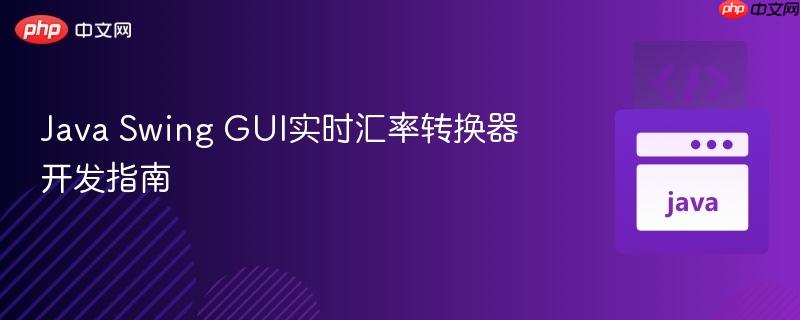
在开发货币转换器应用时,核心挑战之一是如何获取并维护最新的汇率数据。硬编码汇率不仅效率低下,且无法保证数据的实时性和准确性。理想的解决方案是利用外部api(应用程序编程接口)来获取实时汇率。然而,这涉及到网络请求、数据解析(通常是json格式)以及正确管理项目依赖等多个环节。本教程将详细阐述如何在java swing应用中实现这一功能,并解决常见的技术难题。
要实现一个动态的货币转换器,我们需要掌握以下几个关键技术:
获取实时汇率的关键在于选择一个可靠的汇率API。例如,可以使用exchangeratesapi.io(请注意,该API可能需要注册和API密钥,且免费层级可能有请求限制)。API通常会返回JSON格式的数据,我们需要解析这些数据以提取所需的汇率信息。
在Java中,通过URL和HttpURLConnection类可以方便地发起HTTP GET请求并读取响应。
import java.io.BufferedReader;
import java.io.InputStreamReader;
import java.net.HttpURLConnection;
import java.net.URL;
public class ExchangeRateFetcher {
private static final String API_BASE_URL = "https://api.exchangeratesapi.io/latest"; // 示例API地址
public String fetchExchangeRates(String baseCurrency, String targetCurrencies) throws Exception {
// 构建完整的API请求URL
// 实际使用时,可能需要添加API密钥等参数,例如:
// String apiUrl = API_BASE_URL + "?access_key=YOUR_API_KEY&base=" + baseCurrency + "&symbols=" + targetCurrencies;
String apiUrl = API_BASE_URL + "?base=" + baseCurrency + "&symbols=" + targetCurrencies;
URL url = new URL(apiUrl);
HttpURLConnection connection = (HttpURLConnection) url.openConnection();
connection.setRequestMethod("GET");
connection.connect();
int responseCode = connection.getResponseCode();
if (responseCode == HttpURLConnection.HTTP_OK) { // 检查HTTP响应码
BufferedReader in = new BufferedReader(new InputStreamReader(connection.getInputStream()));
StringBuilder response = new StringBuilder();
String inputLine;
while ((inputLine = in.readLine()) != null) {
response.append(inputLine);
}
in.close();
return response.toString(); // 返回JSON字符串
} else {
throw new Exception("Failed to fetch exchange rates. HTTP Error Code: " + responseCode);
}
}
}注意事项:
立即学习“Java免费学习笔记(深入)”;
API返回的数据通常是JSON格式的字符串。我们需要一个JSON库来解析这些字符串,并提取出汇率信息。org.json库是一个轻量级的选择。
首先,确保你的项目包含了org.json库。
对于Maven项目,在pom.xml中添加以下依赖:
<dependency>
<groupId>org.json</groupId>
<artifactId>json</artifactId>
<version>20231013</version> <!-- 使用最新稳定版本 -->
</dependency>对于Gradle项目,在build.gradle中添加以下依赖:
implementation 'org.json:json:20231013' // 使用最新稳定版本
如果没有使用依赖管理工具,你可以从Maven Central下载org.json的JAR包,并将其添加到项目的构建路径中。 访问 https://www.php.cn/link/dbea0e6a82f856ae53f9c827665af265 下载。
解析JSON示例:
import org.json.JSONObject;
public class JsonParser {
public double parseRate(String jsonString, String targetCurrency) throws Exception {
JSONObject jsonObject = new JSONObject(jsonString);
if (jsonObject.has("rates")) {
JSONObject rates = jsonObject.getJSONObject("rates");
if (rates.has(targetCurrency)) {
return rates.getDouble(targetCurrency);
} else {
throw new Exception("Target currency " + targetCurrency + " not found in rates.");
}
} else {
throw new Exception("JSON response does not contain 'rates' object.");
}
}
// 示例:解析整个汇率映射
public java.util.Map<String, Double> parseAllRates(String jsonString) throws Exception {
JSONObject jsonObject = new JSONObject(jsonString);
if (jsonObject.has("rates")) {
JSONObject rates = jsonObject.getJSONObject("rates");
java.util.Map<String, Double> rateMap = new java.util.HashMap<>();
for (String key : rates.keySet()) {
rateMap.put(key, rates.getDouble(key));
}
return rateMap;
} else {
throw new Exception("JSON response does not contain 'rates' object.");
}
}
}原始代码中存在大量的if/switch语句,用于处理不同货币对的转换,这使得代码冗余且难以维护。通过引入实时汇率,我们可以彻底消除这些硬编码的逻辑。
我们可以将获取到的汇率存储在一个Map中,然后在用户选择货币时,动态地从Map中查找汇率进行计算。
import javax.swing.*;
import java.awt.event.ActionEvent;
import java.awt.event.ActionListener;
import java.text.DecimalFormat;
import java.util.HashMap;
import java.util.Map;
public class CurrencyConverterGUI extends JFrame {
private static final DecimalFormat df = new DecimalFormat("0.00000");
private JButton btnConvert;
private JPanel JPanelMain;
private JTextField textAmount;
private JComboBox<String> textFrom;
private JComboBox<String> textTo;
private JLabel result;
// 存储实时汇率的Map,键为目标货币代码,值为相对于基准货币的汇率
private Map<String, Double> liveRates = new HashMap<>();
private String baseCurrency = "USD"; // 假设我们的API基准货币是USD
public CurrencyConverterGUI() {
// 初始化货币下拉框
String[] currencies = {"USD", "EUR", "BGN", "BTC", "ADA"};
textFrom.setModel(new DefaultComboBoxModel<>(currencies));
textTo.setModel(new DefaultComboBoxModel<>(currencies));
// 异步加载汇率数据
loadLiveExchangeRates();
btnConvert.addActionListener(new ActionListener() {
@Override
public void actionPerformed(ActionEvent e) {
performConversion();
}
});
// 当基准货币改变时,重新加载汇率
textFrom.addActionListener(new ActionListener() {
@Override
public void actionPerformed(ActionEvent e) {
String selectedBase = (String) textFrom.getSelectedItem();
if (!selectedBase.equals(baseCurrency)) {
baseCurrency = selectedBase;
loadLiveExchangeRates();
}
}
});
}
private void loadLiveExchangeRates() {
// 在后台线程中执行网络请求,避免阻塞GUI
new SwingWorker<Map<String, Double>, Void>() {
@Override
protected Map<String, Double> doInBackground() throws Exception {
ExchangeRateFetcher fetcher = new ExchangeRateFetcher();
// 假设API允许指定基准货币,并返回所有符号的汇率
String allSymbols = String.join(",", ((DefaultComboBoxModel<String>)textTo.getModel()).toArray());
String jsonResponse = fetcher.fetchExchangeRates(baseCurrency, allSymbols);
JsonParser parser = new JsonParser();
return parser.parseAllRates(jsonResponse);
}
@Override
protected void done() {
try {
liveRates = get(); // 获取doInBackground的返回值
// 汇率加载成功后,可以更新UI或提示用户
System.out.println("Live rates loaded for base: " + baseCurrency);
} catch (Exception ex) {
ex.printStackTrace();
JOptionPane.showMessageDialog(CurrencyConverterGUI.this,
"Failed to load live exchange rates: " + ex.getMessage(),
"Error", JOptionPane.ERROR_MESSAGE);
}
}
}.execute();
}
private void performConversion() {
try {
double amount = Double.parseDouble(textAmount.getText());
String fromCurrency = (String) textFrom.getSelectedItem();
String toCurrency = (String) textTo.getSelectedItem();
if (fromCurrency.equals(toCurrency)) {
result.setText(df.format(amount) + " " + toCurrency);
return;
}
// 获取基准货币到目标货币的汇率
// 如果API返回的汇率是相对于一个固定基准货币(如USD),需要进行两次转换
// 例如:USD -> EUR, EUR -> JPY,如果API只提供 USD -> EUR 和 USD -> JPY
// 那么 EUR -> JPY = (USD -> JPY) / (USD -> EUR)
double rate = 1.0;
if (liveRates.containsKey(toCurrency)) {
rate = liveRates.get(toCurrency);
} else {
// 如果API返回的不是所有货币对的直接汇率,可能需要通过基准货币进行中间转换
// 这里假设API返回的是相对于 'baseCurrency' 的所有目标货币的汇率
// 如果 fromCurrency 不是当前 baseCurrency,则需要先将其转换为 baseCurrency
// 比如:从 EUR 转换到 JPY,但API以 USD 为基准
// 则需要 (amount / rate_EUR_to_USD) * rate_JPY_to_USD
// 简化起见,这里假设liveRates已经是相对于 fromCurrency 的汇率,
// 或者在 loadLiveExchangeRates 中已经处理了基准货币的切换
// 更通用的处理方式:如果 API 始终以一个固定货币(如 USD)为基准
// double rateFromBase = liveRates.get(fromCurrency); // 获取 fromCurrency 到基准货币的汇率
// double rateToBase = liveRates.get(toCurrency); // 获取 toCurrency 到基准货币的汇率
// double total = (amount / rateFromBase) * rateToBase; // 转换为基准货币再转换为目标货币
// 这里的 liveRates 假设是根据当前选择的 textFrom.getSelectedItem() 作为 baseCurrency 获取的
JOptionPane.showMessageDialog(this, "Rate for " + toCurrency + " not available.", "Error", JOptionPane.ERROR_MESSAGE);
return;
}
double total = amount * rate;
result.setText(df.format(total) + " " + toCurrency);
} catch (NumberFormatException ex) {
JOptionPane.showMessageDialog(this, "Please enter a valid number for amount.", "Input Error", JOptionPane.ERROR_MESSAGE);
} catch (Exception ex) {
ex.printStackTrace();
JOptionPane.showMessageDialog(this, "Conversion error: " + ex.getMessage(), "Error", JOptionPane.ERROR_MESSAGE);
}
}
public static void main(String[] args) {
JFrame frame = new JFrame("Live Currency Converter");
CurrencyConverterGUI gui = new CurrencyConverterGUI();
frame.setContentPane(gui.JPanelMain);
frame.setDefaultCloseOperation(JFrame.EXIT_ON_CLOSE);
frame.pack();
frame.setVisible(true);
}
}代码重构要点:
通过本教程,我们学习了如何在Java Swing应用中集成外部API以获取实时汇率数据。关键步骤包括正确引入org.json库、使用HttpURLConnection发起网络请求、解析JSON响应,以及将这些动态数据集成到GUI逻辑中。通过重构代码,我们移除了硬编码的汇率,使应用更具动态性和可维护性。遵循异步处理、错误处理和依赖管理的最佳实践,可以构建一个健壮且用户友好的货币转换器应用。
以上就是Java Swing GUI实时汇率转换器开发指南的详细内容,更多请关注php中文网其它相关文章!

Windows激活工具是正版认证的激活工具,永久激活,一键解决windows许可证即将过期。可激活win7系统、win8.1系统、win10系统、win11系统。下载后先看完视频激活教程,再进行操作,100%激活成功。

Copyright 2014-2025 https://www.php.cn/ All Rights Reserved | php.cn | 湘ICP备2023035733号